The AMD A8-7670K APU Review: Aiming for Rocket League
by Ian Cutress on November 18, 2015 8:00 AM ESTGaming Benchmarks: Mid-Range
Limited-budget users who want to pair an APU with a midrange card might have $200 to $300 to spend on a previous-generation high-end card, or a current-generation "almost the top" offering. To that end, we run our tests with a GTX 770 Lightning (essentially a GTX 680) and an interesting member in an R9 285, which features AMD’s Tonga GPU microarchitecture.
Alien: Isolation
If first-person survival mixed with horror is your sort of thing, then Alien: Isolation, based off of the Alien franchise, should be an interesting title. Developed by Creative Assembly and released in October 2014, Alien: Isolation has won numerous awards, ranging from Game Of The Year to several top 10s/25s and Best Horror titles, ratcheting up over a million sales by February 2015. Alien: Isolation uses a custom-built engine that includes dynamic sound effects and should be fully multicore enabled.
For low-end graphics, we test at 720p with Ultra settings, whereas for mid- and high-range graphics, we bump this up to 1080p, taking the average frame rate as our marker with a scripted version of the built-in benchmark.
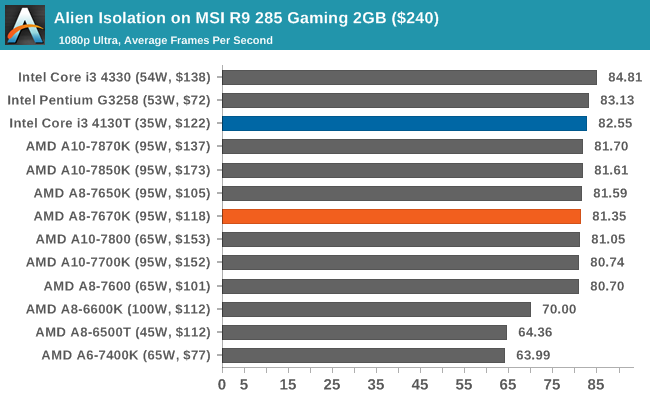
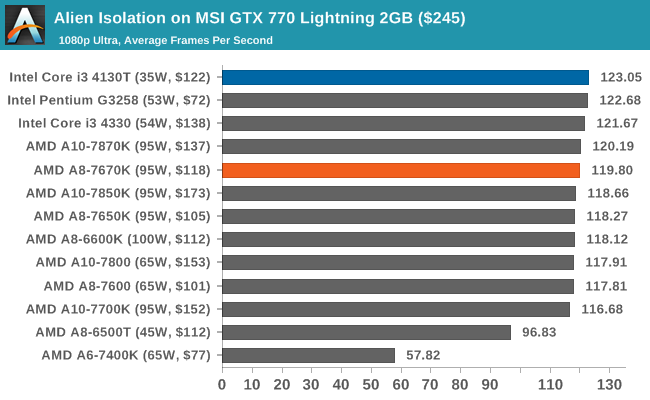
Total War: Attila
The Total War franchise moves on to Attila, another Creative Assembly development, and is a stand-alone strategy title set in 395AD where the main story line lets the gamer take control of the leader of the Huns in order to conquer parts of the world. Graphically, the game can render hundreds/thousands of units on-screen at once, all with their individual actions, and can put some of the big cards to task.
For low-end graphics, we test at 720p with performance settings, recording the average frame rate. With mid- and high-range graphics, we test at 1080p with the quality setting. In both circumstances, unlimited video memory is enabled, and the in-game scripted benchmark is used.
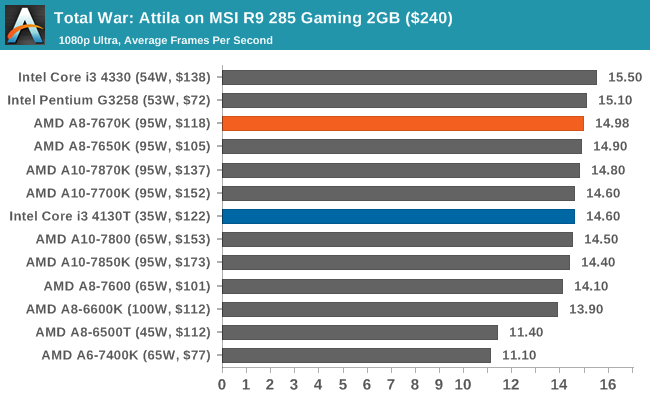

Grand Theft Auto V
The highly anticipated iteration of the Grand Theft Auto franchise finally hit the shelves on April 14, 2015, with both AMD and NVIDIA in tow to help optimize the title. GTA doesn’t provide graphical presets, but it opens up the options to users and extends the boundaries by pushing even the hardest systems to the limit using Rockstar’s Advanced Game Engine. Whether the user is flying high in the mountains with long draw distances or dealing with assorted trash in the city, when cranked up to maximum, it creates stunning visuals but hard work for both the CPU and the GPU.
For our test, we have scripted a version of the in-game benchmark, relying only on the final part, which combines a flight scene with an in-city drive-by, followed by a tanker explosion. For low-end systems, we test at 720p on the lowest settings, whereas mid- and high-end graphics play at 1080p with very high settings across the board. We record both the average frame rate and the percentage of frames under 60 fps (16.6 ms).
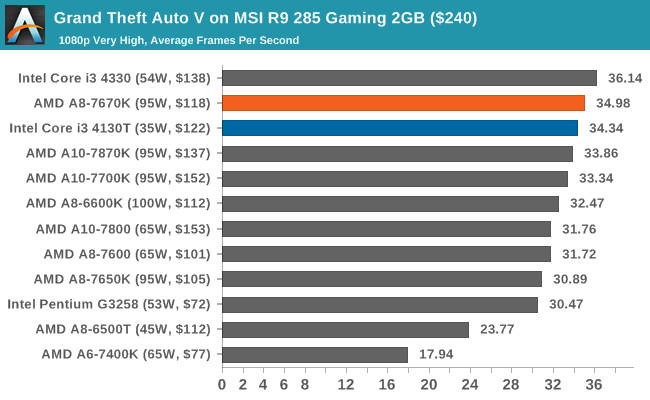
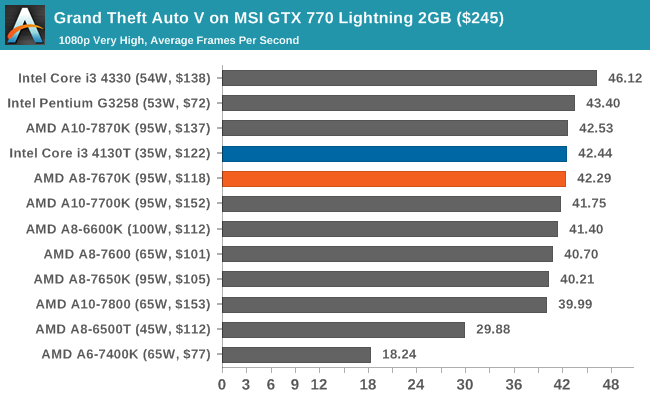
GRID: Autosport
No graphics test is complete without some input from Codemasters and the Ego engine, which means for this round of testing, we point toward GRID: Autosport, the next iteration in the GRID and racing genre. As with our previous racing testing, each update to the engine aims to add in effects, reflections, detail and realism, with Codemasters making "authenticity" a main focal point for this version.
GRID’s benchmark mode is very flexible, and as a result, we created a test race using a shortened version of the Red Bull Ring with 12 cars doing two laps. The player car is in focus throughout this benchmark and starts last, but usually finishes second or third. For low-end graphics, we test at 1080p and medium settings, whereas mid- and high-end graphics get the full 1080p maximum. Both the average and the minimum frame rates are recorded.
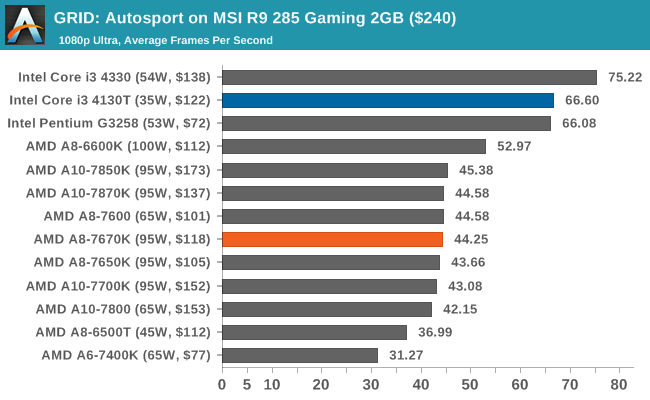
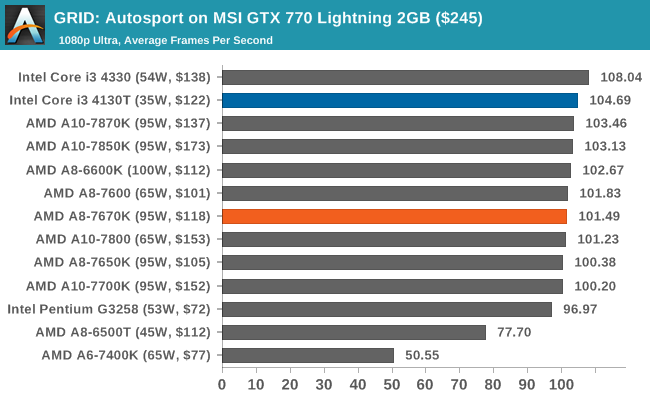
Middle-Earth: Shadows of Mordor
The final title in our testing is another battle of system performance with the open-world action-adventure title Shadow of Mordor. Produced by Monolith using the LithTech Jupiter EX engine and numerous detail add-ons, SoM goes for detail and complexity to a large extent, despite having to be cut down from the original plans. The main story was written by the same writer as Red Dead Redemption, and it received Zero Punctuation’s Game of The Year in 2014.
For testing purposes, SoM gives a dynamic screen resolution setting, allowing us to render at high resolutions that are then scaled down to the monitor. As a result, we get several tests using the in-game benchmark. For low-end graphics, we examine at 720p with low settings, whereas mid- and high-end graphics get 1080p Ultra. The top graphics test is also redone at 3840x2160, also with Ultra settings, and we also test two cards at 4K where possible.

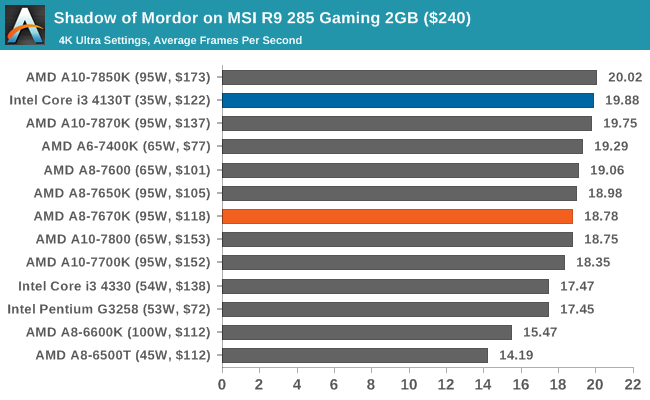

Unfortunately, our GTX 770 gave some odd results in SoM for 1080p. We're trying to get to the bottom of this, and it's an issue we've seen before but have never been able to pinpoint. It seems that a GTX 770 at 1080p performs better without an Internet connection, which is odd, or the problem could be something else entirely. More investigation is needed.















154 Comments
View All Comments
tipoo - Thursday, November 19, 2015 - link
In DX12 that will matter, in DX11 going from single threaded to multithreaded for draw calls doens't help. Check the link.tipoo - Thursday, November 19, 2015 - link
On the other hand " Also note that the FX 6300's DX12 results on R7 260X, GTX 970 and R9 290X comprehensively beat the more expensive Core i3 4130."silverblue - Thursday, November 19, 2015 - link
A lot may be simply down to the number of floating point units; the Pentium has two, the i3 has two with turbo and hyperthreading, and the FX6300 has three with turbo and a sort of hyperthreading mode as the FlexFPU can handle two 128-bit instructions at once or work together for a single 256-bit instruction, though Piledriver is horrendously crippled with the latter.Kutark - Thursday, November 19, 2015 - link
I feel like a "bruh" would have been better here instead of "dude".Morawka - Thursday, November 19, 2015 - link
no because of cache size, and more actual hardware on the i7's diehojnikb - Saturday, November 21, 2015 - link
What kind of actual hardware does i7 have, that i3 dont ?I mean, i3 is really just an i7 cut in half.
eanazag - Wednesday, November 18, 2015 - link
I fully expect AMD to disappoint with Zen. I see no facts that indicate they will not do what they did in the past - fail to meet expectations at the time they said they would.Oxford Guy - Wednesday, November 18, 2015 - link
Just like when they were beating Intel's Netburst.JoeMonco - Wednesday, November 18, 2015 - link
And that was what? Like 15 years ago? It's definitely brought AMD great financial success that they beat a CPU microarchitecture from nearly 2 decades ago.silverblue - Thursday, November 19, 2015 - link
I don't think anybody was saying that.